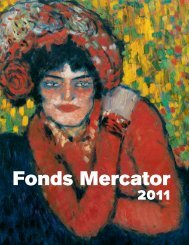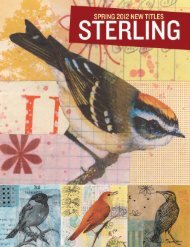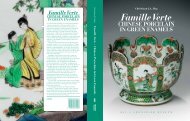pdf 1 - exhibitions international
pdf 1 - exhibitions international
pdf 1 - exhibitions international
You also want an ePaper? Increase the reach of your titles
YUMPU automatically turns print PDFs into web optimized ePapers that Google loves.
chapter fourteen<br />
Of all the construction toys described in this book, Lego is<br />
probably the best known. There cannot be many middle-class parents<br />
over the last fifty years who do not know what it feels like to step with<br />
bare feet onto an unexpected Lego brick lying in wait on the carpet. Lego is a toy<br />
with a long history. The first Lego plastic bricks appeared in 1947, the current<br />
version in 1958, and in 2000 Lego was named ‘Toy of the Century’ by Fortune<br />
magazine in the US and by the Toy Retailers Association in Britain. 1<br />
The origins of Lego are quite complicated. The basis of Lego, in the beginning,<br />
is the interlocking brick. There were interlocking bricks in the 1930s, such<br />
as Bild-O-Brik in the US in 19342 and the British Minibrix, which we have<br />
written about in Chapter 9. These bricks offered a limited range of shapes, and<br />
had studs on the bottom that interlocked with corresponding holes in the row of<br />
bricks below. Because they are rubber, the studs on the bricks deform slightly to<br />
lock the bricks securely together.<br />
Next on the scene were the wooden American Bricks, made by Halsam, the<br />
makers of the Lincoln Logs that appeared in Chapter 6 (Halsam also made the<br />
earlier, non-studded American Brick Blocks). 3 Halsam was founded in 1917 by<br />
two brothers-in-law, Harold Elliot and Sam Goss, Jr., who combined their names<br />
to form the company’s. One source says that Harold’s son, Kip, came back from<br />
England, where he had spent time as a child in the 1940s and discovered his<br />
176<br />
Lego<br />
and the<br />
Green City<br />
favourite toy, Minibrix; he helped launch American Bricks, which were made<br />
using the machinery that Halsam used to mass-produce checkers (draughts to<br />
the British) and dominoes. 4 However, another states that the first American<br />
Bricks patent was filed in 1939, 5 so the origin is clearly disputed. Perhaps Kip’s<br />
sojourn in England was in the 1930s, rather than during the Blitz, and then the<br />
whole thing would make sense, as the American Bricks patent is clearly later<br />
than that for Minibrix. The basic wooden American Brick has eight raised studs<br />
on the top, whereas the basic Minibrix brick has two studs on the bottom, but<br />
unlike their rubber predecessors, American Bricks interlock fairly loosely. This<br />
means they are fixed in relation to one another and cannot slide around, but they<br />
do not stay together if you pick them up. This makes them a halfway house<br />
between the plain blocks of Richter’s and Lott’s and the fully interlocking blocks<br />
of Minibrix and Lego.<br />
In some ways American Bricks were a ‘green’ product. Apparently Sam Goss<br />
used to let the workers go home early on days when the factory got too hot, 6<br />
which would mark him as a green employer, or maybe they just didn’t have air<br />
conditioning; these days the lack of air conditioning might class the factory as a<br />
green building. And of course Sam’s bricks were made of wood, a natural renewable<br />
resource, just like Minibrix, which were made of natural rubber. However,<br />
the world was moving away from natural renewable resources towards plastics<br />
made from oil (and natural gas). 7 Halsam duly followed the trend, making plastic<br />
bricks called, with glorious logic, American Plastic Bricks, which were a close<br />
copy of American (wooden) Bricks8 . Both the wooden and plastic versions had<br />
cardboard windows and doors, 9 tastefully printed with curtains and blinds, 10<br />
which fitted into slots in the bricks in the same manner as the celluloid windows<br />
of Minibrix. Later the windows changed to plastic ones that could be opened.<br />
The roofs are also like Minibrix roofs, but in cardboard rather than rubber, and<br />
American Plastic Bricks had lintels, like the Minibrix ones, for spanning openings.<br />
11 When Messrs Elliot and Goss went into plastics moulding in a big way<br />
they formed a separate company called Elgo (from Elliot and Goss), 12 which<br />
seems to have taken over the manufacture of American Plastic Bricks, although<br />
the Elgo sets do not appear to have had lintels. 13 The Australian copy of American<br />
Plastic Bricks, called Bilda-Brix, did not have lintels either, but did have narrow<br />
metal strips to support the bricks over the openings. These were unconvincingly<br />
replaced by bits of cardboard in the New Zealand version of Bilda-Brix. 14 Our<br />
experience is that Bilda-Brix definitely do not interlock sufficiently to allow a<br />
Lego and the Green City 177










![01 -[BE/INT-2] 2 KOL +UITGEV+ - exhibitions international](https://img.yumpu.com/19621858/1/184x260/01-be-int-2-2-kol-uitgev-exhibitions-international.jpg?quality=85)






